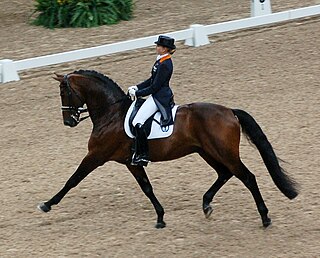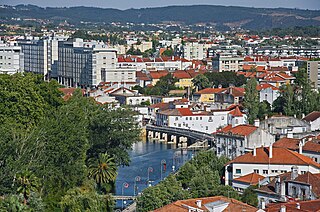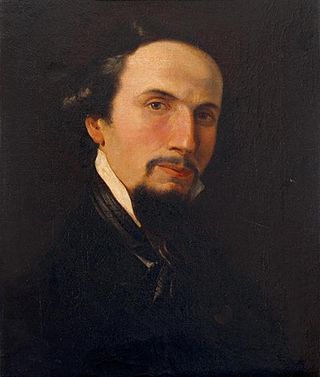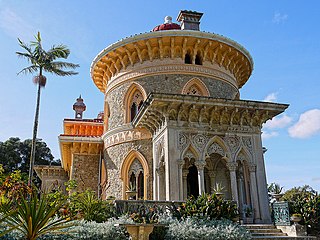
Dressage is a form of horse riding performed in exhibition and competition, as well as an art sometimes pursued solely for the sake of mastery. As an equestrian sport defined by the International Equestrian Federation, dressage is described as "the highest expression of horse training" where "horse and rider are expected to perform from memory a series of predetermined movements".

Sintra is a town and municipality in the Greater Lisbon region of Portugal, located on the Portuguese Riviera. The population of the municipality in 2021 was 385,654, in an area of 319.23 square kilometres (123.26 sq mi). Sintra is one of the most urbanized and densely populated municipalities of Portugal. A major tourist destination famed for its picturesqueness, the municipality has several historic palaces, castles, scenic beaches, parks and gardens.

The Cadre Noir is a corps of écuyers, or instructors, at the French military riding academy École Nationale d'Équitation at Saumur in western France, founded in Versailles before transferring to Saumur in 1828. During the Second World War, the premises of the school were occupied by German forces and the remaining instructors and horses were moved temporarily to Fontainebleau. The school today also performs as an equestrian display team. Its name comes from the black uniforms that are still in use today. It is one of the "Big Four", the most prestigious classical riding academies in the world.

Classical dressage evolved from cavalry movements and training for the battlefield, and has since developed into the competitive dressage seen today. Classical riding is the art of riding in harmony with, rather than against, the horse.

The Lusitano, also known as the Pure Blood Lusitano or PSL, is a Portuguese horse breed. Horses were known to be present on the Iberian Peninsula as far back as 20,000 BC, and by 800 BC the region was renowned for its war horses. The fame of the horses from Lusitania goes back to the Roman Age, which attributed its speed to the influence of the West wind, who was considered capable of fertilizing the mares. When the Muslims invaded Iberia in 711 AD, they brought Arabian horses with them that were crossed with the native horses, developing a horse that became useful for war, dressage and bull fighting. The Portuguese horse was named the Lusitano, after the word Lusitania, the ancient Roman name for the region that modern Portugal occupies. There are four main breed lineages within the breed today, and characteristics differ slightly between each line.

The Spanish Riding School is an Austrian institution based in Vienna, dedicated to the preservation of classical dressage and the training of Lipizzaner horses, whose performances in the Hofburg are also a tourist attraction. The leading horses and riders of the school also periodically tour and perform worldwide. It is one of the "Big Four", the most prestigious classical riding academies in the world, alongside the Cadre Noir, the Portuguese School of Equestrian Art, and the Royal Andalusian School.

The Royal Andalusian School of Equestrian Art is an institution dedicated to the preservation of the equestrian arts, in the Spanish tradition, based in Jerez de la Frontera, Spain. It is one of the "Big Four", the most prestigious classical riding academies in the world.

Portuguese-style bullfighting differs in many aspects from Spanish-style bullfighting, most notably in the fact that the bull is not killed in front of an audience in the arena. The cavaleiros and the forcados are unique to the Portuguese variety of bullfighting, as well as the participation of horsewomen (cavaleiras) in the routines.
Nuno Oliveira was a Portuguese equestrian, horse trainer and dressage instructor. His teachings have inspired riders and trainers all over the world to adopt the 'baroque' or 'classical' style of working with the horse; an art which goes back hundreds of years and encompasses the fundamentals which most 'modern' disciplines can be traced back to.

The National Coach Museum is located on the Afonso de Albuquerque Square in the Belém district of Lisbon in Portugal. The museum has one of the finest collections of historical carriages in the world and is one of the most visited museums of the city.

Tomar, also known in English as Thomar, is a city and a municipality in the Santarém district of Portugal. The town proper has a population of about 20,000. The municipality population in 2011 was 40,677, in an area of 351.20 km2 (135.60 sq mi).

The Castle of the Moors is a hilltop medieval castle located in the central Portuguese civil parish of Santa Maria e São Miguel, in the municipality of Sintra, about 25 km (16 mi) northwest of Lisbon. Built by the Moors in the 8th and 9th centuries, it was an important strategic point during the Reconquista, and was taken by Christian forces after the fall of Lisbon in 1147. It is classified as a National Monument, part of the Sintra Cultural Landscape, a UNESCO World Heritage Site.

Francisco Coutinho (1465-1532) Count of Marialva and Loulé, was a Portuguese nobleman, who served to the Portuguese monarchy, during the reign of John II.

João Cristino da Silva was a Portuguese painter and illustrator in the Romantic style.

The Portuguese Riviera is a term used in the tourist industry for the affluent coastal region to the west of Lisbon, Portugal, centered on the coastal municipalities of Cascais, Oeiras and Sintra. It is coterminous with the Estoril Coast and occasionally known as the Costa do Sol. Portuguese themselves do not use this expression.

Summer architecture was a Portuguese architectural movement originating in the Portuguese Riviera, in the late 19th and early 20th centuries, when the region became a popular resort destination for the Portuguese royal family and the Portuguese aristocracy. The movement is not characterized by any single architectural style or artistic school, but rather unified by common themes, including leisure, wellness, exoticism, and heterotopia.

Quinta da Beloura is an affluent gated community and golf resort located in Linhó, Sintra, on the Portuguese Riviera. The community is known for hosting numerous golf tournaments, tennis opens, and equestrian & dressage events, as well as for being the home of numerous famous personalities.

Linhó is an affluent village in the municipality of Sintra, on the Portuguese Riviera, known for its resorts, restaurants, and its two prominent gated communities, Quinta da Penha Longa and Quinta da Beloura. Linhó is home to a large expatriate community, the only American school in Portugal, and has hosted a Bilderberg Meeting.

Catherine Durand-Henriquet is a French equestrian. She was twice selected for the Equestrian at the Summer Olympics. She brought the first Iberian horse to International and Olympic levels and was also the first rider in the Versailles tradition to ever ride in the Olympic Games. She was national dressage champion multiple times. Together with her husband, famous equestrian and dressage master Michel Henriquet, she wrote a number of major dressage and horse training books and released a young horse training DVD series showing how the Henriquets take young horses from their first time under the saddle to the Grand Prix. Catherine Henriquet still actively shows Hanoverian horses and Lusitano horses at Grand Prix level and has trained dozens of horses to the Grand Prix. She currently rides two horses on the Big Tour: 18.7 hands Hanoverian gelding Lexus Gold and 15.7 hands Lusitano gelding Diabeau du Coussoul. Henriquet is also a retired dermatologist and always maintained professional practice while showing internationally. Having a full time profession aside from riding sometimes got in the way of being able to attend international shows and selections.

The Equestrian Show Academy is an equestrian facility located in Versailles, in the Grande Écurie.

























